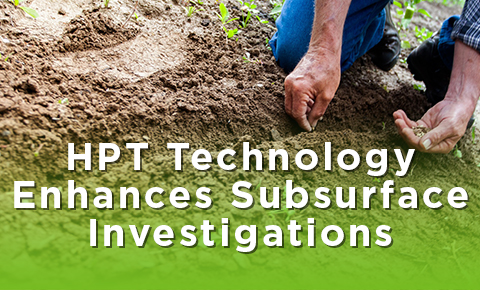Using HPT Technology to Enhance Subsurface Investigations
May 7, 2020

Understanding groundwater preferential pathways is a critical link in the development of conceptual site models and the design of groundwater remediation strategies. Identifying and mapping transmission zones that contaminants favor, or “preferential pathways,” is crucial when making decisions about how to best approach groundwater remediation at a site. Time and money can be saved by using technology to quickly gain a comprehensive picture of subsurface hydrogeologic conditions.
Hydraulic Profiling Tool (HPT) systems are an asset in gaining a detailed picture of the subsurface. Used with mobile drilling platforms, an HPT probe system can provide boring logs that make it easy to interpret subsurface soil characteristics.
Defining Compounds Found in Soil and Groundwater
VOCs (volatile organic compounds) are legally defined, but generally are organic compounds that evaporate at low temperatures, typically room temperature or below. Because of their volatility, they are more mobile than many other compounds. The USEPA and other regulatory agencies set limits for many VOCS in air, soil and water.
SVOCs (semi-volatile organic compounds) are legally defined but have lower volatility and evaporate at higher temperatures than VOCs. Because of their lower volatility, they can remain in soil or water for long periods of time and accumulate more readily than VOCs. The USEPA and other regulatory agencies set limits for many SVOS in air, soil and water.
HPT Operation and Benefits
An HPT system operates by applying water through a small opening on the side of the drilling probe as it is advanced through the subsurface. Water pressure and flow rate are monitored by the HPT logging system and displayed in real time. Sandy soils that contaminants favor and clays that affect groundwater flow are easily identified. Electrical conductivity logs can also be generated using the HPT system for an added parameter in interpreting subsurface conditions.
A Membrane Interface Probe (MIP) can operate in conjunction with an HPT, and is used to detect the presence of volatile organic compounds (VOCs) in real time and at accurate depths. An added benefit of HPT, electrical conductivity and MIP technology is their footprint. Nothing is removed from the subsurface which means investigation waste, along with the associated disposal costs, is nearly eliminated.
Case Study: Using HPT in the Field
McFadden Engineering (MEI) utilized HPT boring logs to create stratigraphic cross sections to develop a conceptual model of groundwater flow at a large site near Mobile, Alabama. A product released into soil and groundwater at an industrial facility impacted groundwater quality over many acres. MEI was retained by the client to conduct a subsurface investigation and design an effective remediation strategy.
Preliminary site assessments revealed a very complex geologic lithology. Using HPT in conjunction with discrete groundwater sampling conducted at various depths, geologists and engineers at MEI identified preferential flow pathways for contaminated groundwater at the site. This information was used to construct two remediation systems designed to intercept, capture and treat contaminated groundwater prior to interacting with surface water in the area. Recovery wells were installed at depths that coincided with preferential pathways identified using HPT to efficiently target contaminated zones.
In teaming up with our industry partners and utilizing HPT and MIP technology, MEI can bring great value to clients that need quick assessment of subsurface conditions. By identifying and targeting groundwater preferential pathways, MEI can design effective remedial options tailored to specific site hydrogeologic and contaminant properties.